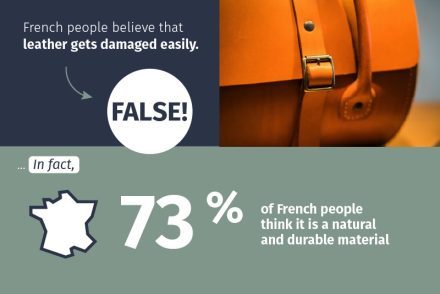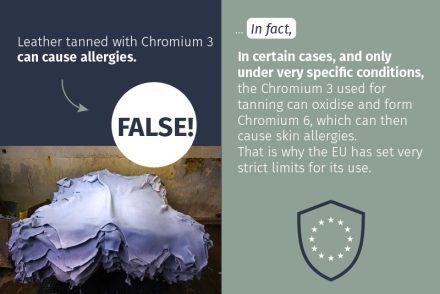Six leather popular beliefs examined in detail The - Leather - Première Vision Paris
Despite its sustainability, circular production and commitment to CSR, leather is unfairly criticized for its environmental impact, and is the subject of many popular beliefs.
Circular economy, farming, harmlessness, perception, pollution and resources: here are 6 popular beliefs about leather examined and refuted by the Conseil National du Cuir (CNC) and Première Vision.

Popular belief #1: French people believe that leather gets damaged easily
False!
More than 73% of French people consider leather to be a durable material and 63% say that a leather item lasts longer than a textile item.
Source: Étude de la perception et des usages du cuir par les Français – Happydemics-CNC 2021
Popular belief #2: Leather production pollutes the environment
False!
All French tanneries are environmentally-classified facilities (Installations Classées pour la Protection de l’Environnement (ICPE)). They therefore respect the Ministerial Decree of 2 February 1998 on sampling, water consumption and discharges of all forms. In addition, government inspectors monitor compliance with directives on waste management, processing aqueous discharges, emissions and non-pollution of soils.
At the European level, the IED Directive governs industrial emissions to ensure a reduction in the pollution generated by industrial activities including tanning. Outside of the European Union, almost all countries have environmental protection regulations.
Source: Aida Ineris – Minister for the Ecological and Solidarity Transition – ICPE Legislation / Ministerial Decree of 2/02/1998

Popular belief #3: Cows are farmed specifically for their hides
False!
The slaughter of farm animals in Europe is strictly regulated and the skin used to produce leather represents less than 5% of the price of the carcass*.
How can we then think that these animals are farmed just for their skins?
In reality, leather is a by-product of the agri-food industry, and an element of the circular economy. Furthermore, French leather experts work with farmers to guarantee the integrity and quality of their skins.
*Source: Fédération Française des Cuirs et Peaux.
Popular belief #4: The leather industry uses a lot of water
That is true but…
The leather industry uses between 12 and 37m2 of water per ton of bovine hide1. However, 60 – 70% of that water is used in the preparation of the skin, which would otherwise be considered a waste product by the agri-food industry were it not transformed into leather.
In Europe, the water used is returned to the natural environment after being treated and the residues from the cleaning of raw hides are transformed into fertilizer, fuel or technical gelatin.
*Source: Union Internationale des Techniciens et Chimistes des Industries du Cuir.

Popular belief #5: The leather industry is an upcycling industry.
True!
Each year, more than 160 000 tons of skins from animals raised for their milk or meat are transformed into leather.
During this process, the residues of the pre-tanning cleaning stages, as well as offcuts and leather dust created by the manufacture of the finished product can be reused to create new materials and insulation, placing the industry firmly in a circular, recycling economy.

Popular belief # 6: Leather tanned with Chromium III can cause allergies.
False!
Chrome tanning represents more than 80% of leather tanning worldwide. The chromium used is a trivalent form: chromium III. It is possible, under certain very specific conditions, that a tiny part of this chromium 3 can oxidize to chromium VI, an allergenic component when in contact with the skin.
That is why the European Union has set a limit of 3 mg/kg* for leathers that come in contact with the skin.
*Source: Eur-Lex – European Union – Regulation (CE) N° 301/2014 – REAC
Would you like to know more about the French leather industry? Take a look at the website of the Conseil National du Cuir and its myth-busting platform: Le Cuir en Vrai.
And to explore the key CSR issues facing the leather industry from a social, environmental and economic perspective, do not miss the 4th edition of the Sustainable Leather Forum.
For this new edition, new topics will be addressed: the role, approaches and innovation of chemistry companies, the market for leather for automobiles, CSR approaches of other soft materials, and finally the traceability of skins, materials and finished goods.
Find us at the Première Vision stand during this event focused on reflection and innovation and held on 12 September 2022 at Palais Brongniart in Paris.
Find out more ➔
